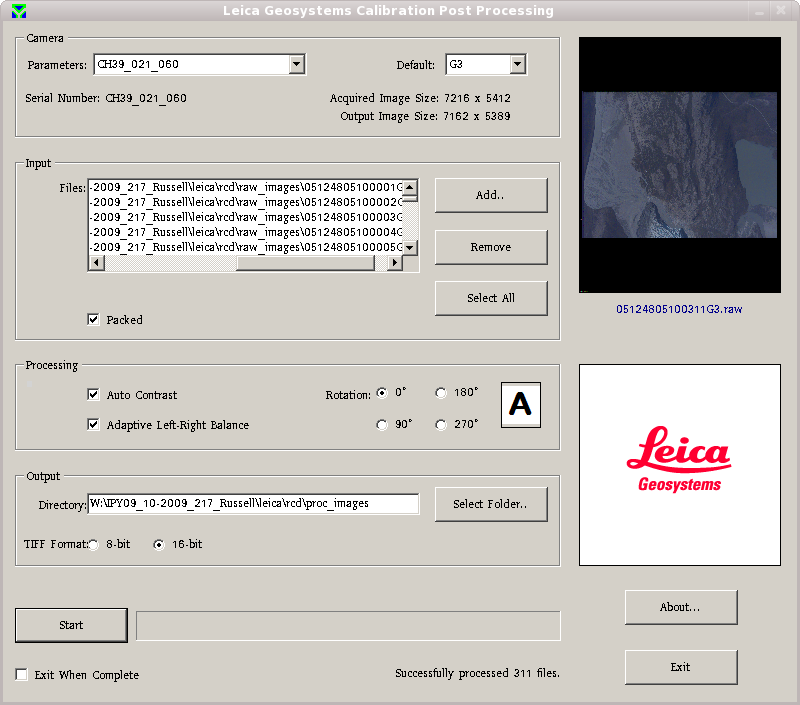| Version 3 (modified by mark1, 14 years ago) (diff) |
|---|
RCD camera image processing at ARSF DAN
Currently the processing of the RCD images consists of the raw file format conversion into a TIFF image, and tagging of supplementary information.
Raw to TIFF conversion
The raw images are converted to TIFF using the Leica RCD processing software. This unpacks the raw data from 12 byte to 16 byte data and applies the given calibration gain and dark file data. The software applies some "auto contrast" and "adaptive left/right balance" algorithms during the data calibration. The images are not rotated nor geocorrected in any way.
Basic Image Processing
The RCD outputs raw images which are processed to create TIFFs. There are several image processing steps that are applied to each raw image.
- Bias Correction
The XXXd.tif file is used to subtract for ‘dark’ signals. “XXX” is the name of the camera parameters file. - System Response Correction
The XXXg.tif file is used to correct for Pixel Response Non-Uniformity (PRNU) and for a first order system falloff in light across the image frame. “XXX” is the name of the camera parameter file. - Color Processing
The XXXp.txt camera parameter file contains information on the camera regarding the Bayer array, color response, white balancing, and flaws. It is used to correctly interpolate from a Bayer image to full color RGB TIFF image, correct for color, white balance, and interpolate over flaws.
Pre 2010
The camera used a smaller portion of the CCD in calibration - and may have resulted in smaller final images.
2010 onwards
Improved full frame CCD which should improve the radiometric calibration. The left/right balancing should perform better after this improvement.
Event file updated
The image events file is updated at this point to contain the post-processed quality data rather than the real-time position and attitude data. Also the exterior angles omega, phi and kappa are added on to the events file.
Image tagging
After TIFF image creation the photographs are 'tagged' with information relating to the aircraft position. This includes the time stamp when the image was captured, post-processed navigation data (position and attitude) including the sensor lever arm such that given positions are relative to the sensor. The boresight is not currently calculated for the camera, and will therefore appear as a constant roll / pitch / heading error term in each photograph. The exterior angles are also tagged on to the images.
Quality control
Images are sometimes removed from deliveries if they are deemed to be 'bad'. This includes images that are very under or over exposed, and also may include images that do not cover the flight project area.
Thumbnail generation
As the processed TIFF images are quite large, we generate thumbnails of them for quicker and easier viewing.
KML generation
We generate a KML file, which is a google earth file, which shows the aircraft positions at specific times, the eagle and hawk flight lines' location and the photograph locations.
Further processing ideas
Orthophotos
This apparently takes another week long training course. We do have the basic software to do it but limited knowledge. Basic process is to determine the camera parameters, correct and overlay the images, keeping ideally only the most central parts. You then have to manually check through, especially along seams, and manually move the seam line in some instances (e.g. when perspective effects result in odd errors due to the seam hitting a tall building).
